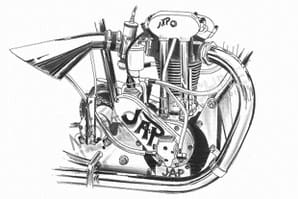
He had been unimpressed by what he saw, considering the new sport to be yet another passing craze, just like the earlier roller skating fad. He gave it six months at the very most before, to use his own words it will burst like a bubble'.
Fortunately, Stan Greening, the company's Chief Technical Advisor who had taken him to Stamford Bridge, thought otherwise. At that time the Douglas twin was all-conquering, but the pattern was soon to change, thanks to the intervention of Bill Bragg, Captain of the Stamford Bridge team. He could see a big future for a suitably developed JAP engine and knowing that Vivian Prestwich, the eldest of John's five sons, was very keen on racing, he spoke to him on the JAP stand at the 1929 Motor Cycle Show. Vivian was quick to see his point and prevailed upon his father to reconsider his outlook. After due thought, he gave the speedway engine project his blessing and work commenced in the capable hands of Stan Greening.
Enjoy more Classic MotorCycle reading in the monthly magazine.
Click here to subscribe & save.
350cc racing engine
The first engine followed the lines suggested by Bill Bragg, starting with a 350cc racing engine with which Stan himself and Teddy Prestwich, another of John's sons, had gained some world records at Brooklands. Its weight was reduced some 11Ibs by using the crankcase from a 250cc engine and a single-port 350cc cylinder head with the combustion chamber reshaped, the cylinder having come from a 500cc single after paring off its cooling fins. It was given to Bill for trial, but was well down on power and no match for the four-valve Rudge that was beginning to displace the Douglas.
Undeterred, Stan Greening experimented with cam design, port shapes and angles, and even skimmed the flywheels to reduce weight still further. A small batch of modified engines were loaned to riders of the calibre of Vic Huxley, Billy Lamont and Frank Arthur, to be installed in Harley-Davidson 'Peashooter' frames. But they were still no match for the opposition and with their evening takings threatened, the riders began to look elsewhere. But before Stan had time to feel disappointed, help came from an unexpected quarter.
 Wal Phillips now came back into the picture, having at one time worked in the factory to be near his uncle, Bert Le Vack, whom he worshipped. Already a big name in speedway racing, Wal had just purchased a new Rudge to replace his Douglas. Still an occasional visitor to the factory, news of his change of machine reached the ears of Stan Greening, so when he next called, Stan asked him if he could borrow the Rudge to strip the engine completely. He wanted to see for himself why the engine was proving so successful. Wal consented, and so began a partnership that gave the JAP engine the break it needed.
Wal Phillips now came back into the picture, having at one time worked in the factory to be near his uncle, Bert Le Vack, whom he worshipped. Already a big name in speedway racing, Wal had just purchased a new Rudge to replace his Douglas. Still an occasional visitor to the factory, news of his change of machine reached the ears of Stan Greening, so when he next called, Stan asked him if he could borrow the Rudge to strip the engine completely. He wanted to see for himself why the engine was proving so successful. Wal consented, and so began a partnership that gave the JAP engine the break it needed.
Using the information gleaned from the Rudge engine, Stan and Wal worked long hours in the Experimental Shop. They became so totally absorbed that neither of them realised how they were making life unbearable for those who lived nearby as they ran engines on the test bed late into the night. But their devotion soon paid off, with an engine that developed 33bhp and weighed only 53lbs. By August 1930 the new 80 x 99mm 497cc engine was ready for the crucial test, Lodge Plugs having ,developed a sparking plug that would withstand heat yet not oil up, and Amal Limited their famous track racing carburettor. Stamford Bridge was to be the venue, the engine being mounted in a frame designed by George Wallis which he was anxious to try out. The machine's debut at Stamford Bridge proved highly successful, Wal winning his first two races and breaking the lap record unofficially during practice. But the handling was not all it should have been and he withdrew from the remainder of the meeting. He proved his point by reverting to the Rudge frame when, riding in just three meetings, he recorded 14 wins. The speedway JAP engine had arrived.
Modifications to the Wallis frame made it even better than the Rudge design, and from that point onwards so many clamoured for JAP engines that it became necessary to tool up for mass production at the factory in Tottenham. It had not escaped attention that Wal had won a coveted Gold Star at Brooklands by lapping a 106.5mph on a Grindlay Peerless powered by a similar engine, a feat that was subsequently repeated by Fergus Anderson riding an Excelsior fitted with a speedway JAP engine loaned by Whoolly Worters. Obviously the engine was as robust as it was fast.
Rewarding increase
Many modifications were made during the years that followed, each time accompanied by a rewarding increase in power. During 1931 the crankcases were re-cast to stiffen up the mounting lugs and at the same time to incorporate an integral horizontal set of ribs in the lower portion of each crankcase half. A cast alloy rocker box replaced the rocker standards that were part of the old, cast iron cylinder head, the pushrods now being enclosed and the rocker arms running on a double row of needle roller bearings. Using polished steel flywheels and a compression ratio of 12.5:1, the power output had now risen to 37.5bhp at 5,750rpm.
Due to ever-increasing sales, it soon became impossible for the factory to sell direct to the public. In consequence, a new and entirely independent company was set up close by, run by Victor Martin, a former factory employee. By licensing the manufacture of the Rudge frame and substituting a JAP engine for the original, the new company was able to market a complete speedway machine – the Martin which sold for £87.
 1933 marked the introduction of a modified rocker assembly with a positive oil feed. The connecting rod was made ¾ inch longer, to ease the load on the big end, the cylinder barrel being lengthened the same amount to keep the stroke constant. Power output had now reached 40bhp at 6,000rpm. But there were problems with the cylinder head blowing in the area between the exhaust port and the exhaust valve seat, which led to the addition of an extra cylinder head holding down bolt in the affected area during the 1935 season. Duralumin connecting rods were used for a short period and also parallel-sided shafts with keyways, until problems suggested the original design could not be bettered.
1933 marked the introduction of a modified rocker assembly with a positive oil feed. The connecting rod was made ¾ inch longer, to ease the load on the big end, the cylinder barrel being lengthened the same amount to keep the stroke constant. Power output had now reached 40bhp at 6,000rpm. But there were problems with the cylinder head blowing in the area between the exhaust port and the exhaust valve seat, which led to the addition of an extra cylinder head holding down bolt in the affected area during the 1935 season. Duralumin connecting rods were used for a short period and also parallel-sided shafts with keyways, until problems suggested the original design could not be bettered.
Exhaust port
After the war, the cylinder head was recast with more metal near the exhaust port, which meant the engine could revert to the original four stud layout. This was standardised by 1949. At this time, very few changes in engine specification were needed as the engine was proving highly successful and was in almost universal use.
With many World Championships to its credit, it remained the number one choice until the JAP factory merged with the Villiers Engineering Company in 1957. Thereafter its popularity declined, due to the emergence of the Jawa engine, to be followed in turn by Weslake, Godden and GM, engines that are much easier to ride and require less frequent attention. Yet for all that, the Speedway JAP had the longest run of any engine in this branch of the sport and was, in its day, the most powerful unsupercharged engine of its capacity in the world. The power output from an engine that is so simple in basic design is truly amazing – rough, instant power that demands the greatest of respect. Even today, this 50 year old engine is still capable of giving a good account of itself under the harsh light of competition. ![]()
Advert
 Enjoy more The Classic MotorCycle reading in the monthly magazine. Click here to subscribe.
Enjoy more The Classic MotorCycle reading in the monthly magazine. Click here to subscribe.




